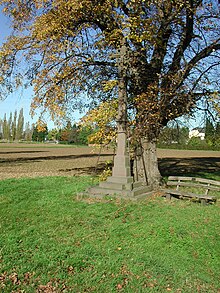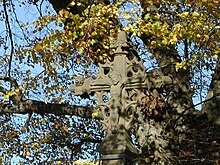Black Cross (Frauwüllesheim)
The Black Cross is a listed field cross on the western edge of Frauwüllesheim in the municipality of Nörvenich , Düren district , North Rhine-Westphalia .
history
The creation of the High Gothic work of art is dated to the turn of the 15th to the 16th century. The listed cross, originally with the assistant figures Maria and Johannes, a wrought-iron wreath decorated with Gothic tracery and three coats of arms, has survived the long period of almost 500 years without damage.
The cross was entered on March 12, 1985 in the monument list of the municipality of Nörvenich under No. 32.
A first technical status report from 1869
"The four, between the main trunk and the transom resulting triangles are filled with delicate tracery .... The main stem and the cross beams are provided at their ends with finials crowned whose foliage obliquely on the vertical axis intersection of the cross standing .. On both sides are the left and right figures in the hl. Virgin and hl. Johannes on small, decorated with foliage ornaments Consölchen that on the upper piece of the shaft by using a metal anchor bolts are fastened ... a circular lilies rim of wrought iron runs, and the supporting work around (are previously four iron support rods described) and is suitable on special occasions for holding burning lights. In front of the foot of the upper part of the shaft and on both sides are three stone coats of arms , one of which still shows the heraldic symbols of the Counts of Binsfeld ".
The report also says:
"At the moment the monument is in a very sad state; on the north-facing side the tracery on the cross has almost completely weathered and fallen off; the top finial and the one at the northern end of the crossbar have disappeared without a trace, and the figure of St. John , whose console is also in danger of falling. Since, however, no part is missing whose side section is not still present, we could not fail to add to the missing in the drawing ".
renovation
The renovation was carried out in 1907/08 by the Aachen sculptor L. Schoepens at the instigation of Pastor Colin and through donations from the parish - "more than 1200 marks", as the Frauwüllesheim-born Professor Dr. Gehlen found out in 1926. The two figures have been completely renewed; the statue of St. John was already missing in 1869, the representation of the Virgin Mary should have passed in the following forty years at this special weather-endangered location.
Renovation backlog
The three coats of arms must have been renewed. Paul Clemen wrote in 1910: "... coat of arms of Duke Wilhelm von Jülich and his wife Sibylla of Brandenburg and the city of Düren ...". The Düren coat of arms is mentioned in a letter from 1635. Since the names of the two other coats of arms are not mentioned in 1869, these stones seem to have been unrecognizable by weather at that time. During the renovation in 1907/08, a l 1/4 m high iron grille and a knee bench in front of it were installed.
Renovation after World War II
In the 1950s, the cross, which was almost completely destroyed in the Second World War, was put up again. The two statues, the coats of arms and the wrought iron ring were not renewed. The statue of Mary and the coat of arms of the city of Düren were secured.
In 1986 the community had the cross, which was endangered by environmental influences, hardened by the Cologne company Ebert.
In May / June 2020, the area around the cross was redesigned.
Processions
The Black Cross was the target of processions . The cross was decorated on Corpus Christi "in earlier years from the Kratz estate" and then the blessing of heaven "was implored in Latin chanting on the fields, on the inhabitants of the village, especially on the consul huius loci, that is the mayor or mayor ".
Until the middle of the 16th century there was a procession from Düren to the Frauwüllesheimer Kreuz. The historian Polius from Düren mentions the cross in a letter from 1635 and cites the previously popular procession on the day of the Visitation as the reason for the installation of the municipal coat of arms .
Dürener Stadtpfarre organized in the 16th century three large processions on Corpus Christi, Ascension Day and the day after the Bittgang after Frauwüllesheim, the " Wüllesheimer Lady ride ".
- "The cost of these three processions was paid for half of the cost of these three processions according to the Jülich rulers, Düren's advice took on the other half, which charged each of the two 45 Marks 8 Schillings 1500/1".
The invoice from 1546 reports "the Lords of Paradise (the Wilhelmite order lords) donated 8 quarts of wine on Wüllesheim's godly costume". According to the calculations, a total of 285 and 1554 even 299 council signs (vouchers of 6 and 8 schillings each) in connection with the Frauwüllesheim procession were distributed to local and foreign priests, guilds , candlesticks, singers and bell ringers at the instigation of the Düren city council .
This pilgrimage was stopped in 1580 .
Until the time between the two world wars, weather processions from Kelz and Vettweiß came to the cross. When the drought was severe and threatened the harvest , the people of Kelz came to Frauwüllesheim on Sunday afternoons "and when it looked particularly bad," the people of Vettweiss also went through the fields to the Black Cross to ask for the crops to be saved . They were mockingly told that they would all bring an umbrella with them, as they feared that they would be soaked in the rain on the way back to Vettweiß.
After the destruction in World War II, the Corpus Christi procession to the Black Cross was discontinued.
The last weather procession from Kelz took place in 1948.
Web links
Individual evidence
- ^ Paul Clemen , Die Kunstdenkmäler der Rheinprovinz , Vol. 9, page 137
- ↑ Error in the indication of the Binsfeld coat of arms, it should not have been counts, but barons of Binsfeld.
- ^ Gehlen, 1926
- ^ Pastor Steffens in his parish history, which was added to the church newspaper from 1951 to 1952 .
Coordinates: 50 ° 47 ′ 34.7 " N , 6 ° 34 ′ 8" E


